Celtic Connections
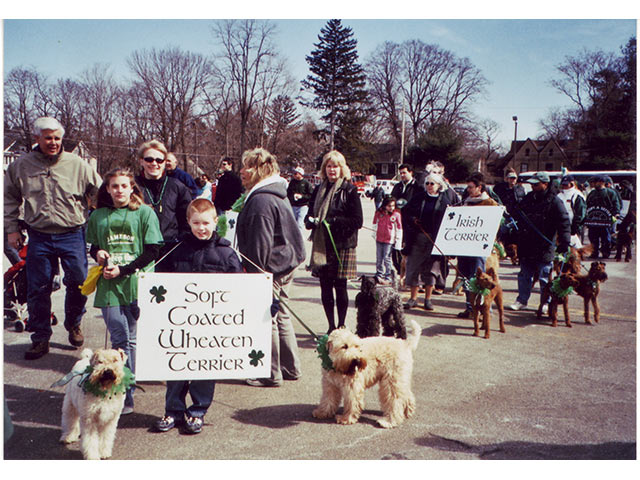
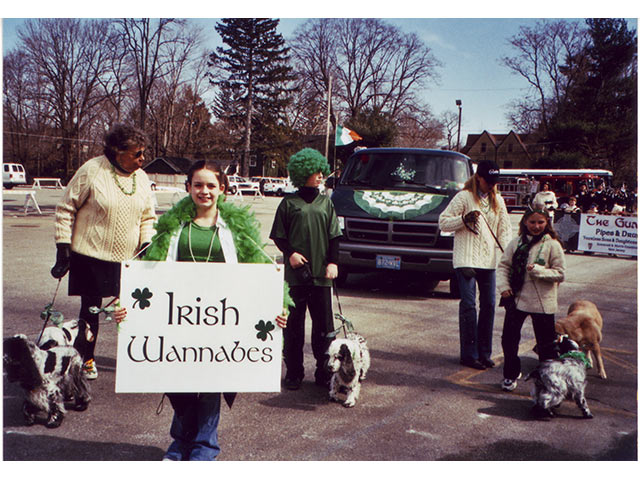
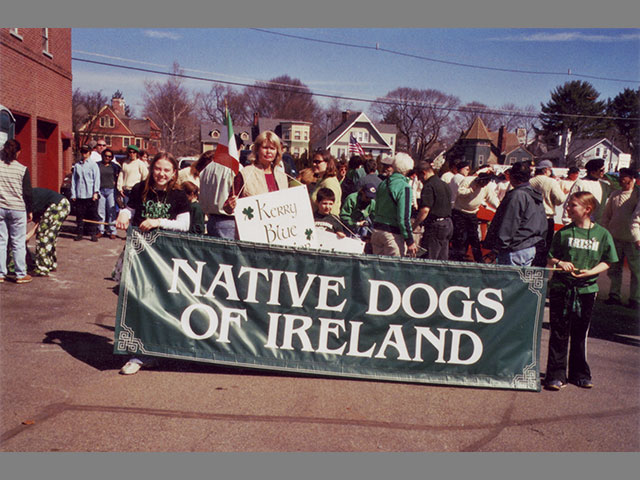
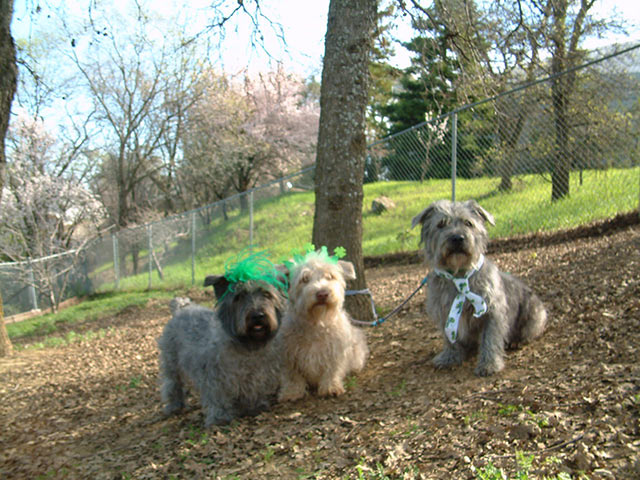
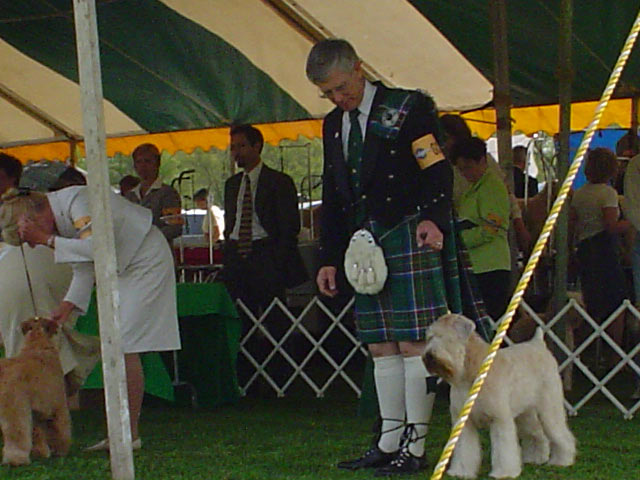
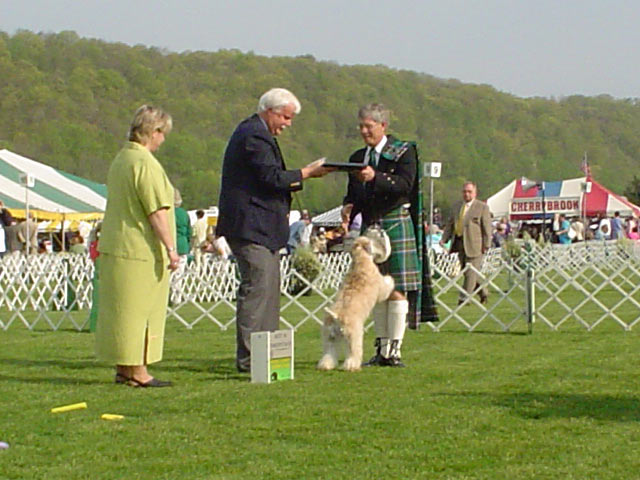
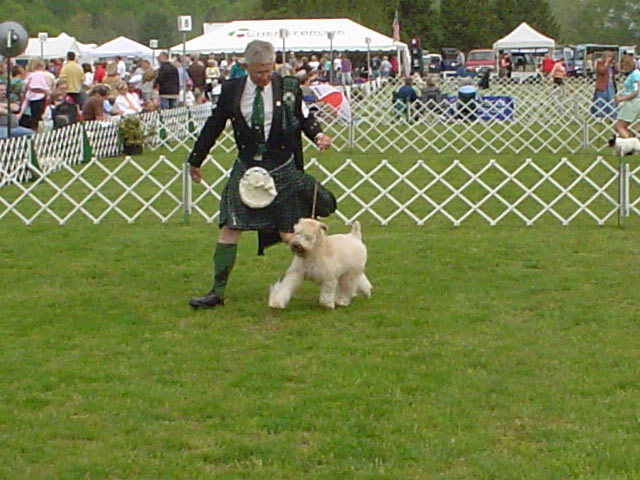
In the spirit of celebration and education, people love coming out to see the dogs and learn something they never knew before. "We call it 'Native Dogs of Ireland,'" Jimmy says. "As we march along the road, everyone wants to pet the dogs. We explain that these dogs originated in Ireland. People see the dogs in the parade, then they are interested in learning more later on."
"With up to 15,000 people," Alice adds, "it's like having a moving AKC education booth. People are often surprised to see how many dogs come from Ireland."
The first year out, the Dicksons were not sure how the dogs would be received, and they were relegated to the end of the procession. But after an overwhelmingly positive response, they moved up the next year, then again the following year. "Now, we're in second position," Alice says, "right behind the politicians."
Digging Up Mysterious Roots
Soon after getting her first Glen of Imaal Terrier in 1998, Lora Clark became a board member for the national club. She also played a role in getting the breed accepted by the AKC in 2004.
Clark was always enamored of the Glen's rough-and-tumble roots. Originally bred to control badgers, rats, and other animals farmers considered pests, she says, "This dog comes from an area of Ireland that was populated by very poor families. They needed a dog to do a lot of work for them."
Clark became interested in Irish breeds partly because of her own heritage. "My grandfather and my great-grandfather were from Ireland, and I have a fascination with Ireland. It means a lot to me to have a dog whose history matches mine." She was also attracted to the Glen's mystery. "Even in Ireland, the story of these dogs is rather obscure."
Clark and her fellow Glen breeders are honored to cultivate an unpolished edge, the same characteristics that were so important to Irish families centuries ago. This is prominently revealed in earth-dog trials, a competition where a dog must find its way to a rat placed in a cage at the end of a tunnel (the rat is not actually hunted by the dog). "The very first time I did this, my dog knocked me over trying to go after the scent," Clark exclaims. "He dove in, turned sideways, and literally restructured the tunnel, digging out the entire thing! He got to the rat cage and held on so tight I couldn't pull him off." People dug the rat cage out and lifted it up. With fondness, Clark recalls, "The rat cage was up in the air, with my dog hanging from it."
Everyone at the earth-trial wanted to know who this mystery dog was. No one there had ever heard of this breed before. Clark remembers the moment when she had an opportunity to introduce her favorite breed, proudly announcing, "This is a Glen of Imaal Terrier. After that, people called me all the time asking to please bring my Glens to the earth trials."
Although the Glen of Imaal is an ancient breed, there is little written about them. This nags at Clark. With determination equal to one of her Glens, she digs for information that might piece together a complete history. "Lots of breeds were created by the rich, and they have thorough records. But we don't have this with Glens. You can really get obsessed. You have just got to know more. The Irish have all these legends about the dogs. Something must be written down somewhere."
No long ago, Clark did find one enticing bit of history, a sketch of the St. George Inn, which is located in England. "It's possible that this sketch dates back to 1361," she says eagerly. "They had these fireplaces with wheels that were turned by a dog. They just call them 'turn spit terriers.'" But to Clark and her fellow breeders, the dog looks strikingly like a Glen of Imaal. "I could easily imagine a Glen turning that wheel all day long!"
Clark is planning to investigate several leads when she travels to Ireland. She wants to go to the source – speak with locals in the town of Glen of Imaal, look at records in the library, try to collect more pieces to this engrossing puzzle.
New Ways to Make Meaning
Beverly Bracken got her first Kerry Blue Terrier in 1989, a dog she picked "by reading through the AKC breed books." That dog became a champion, and Bracken's 18-year attachment began. Bracken is a founding member, and current secretary, of the Kerry Blue Terrier Kennel Club of Central Florida.
It took Bracken several years to get up enough nerve to show a dog herself. "I was terrified and always had someone else handle my dogs." But in 1991, she did go into the ring. "My nine-month-old puppy won at a specialty show. My first major points – that's a feeling I'll never forget."
For five exciting years, Bracken developed a confident ring presence, as she became more involved in the Kerry Blue world. Then, in 1996, everything changed. "I suffered a serious fall, which left me disabled. I have not been able to show my dogs ever since."
But she found other ways to be active. "I started mentoring people one on one, offering any insights I could about the breed, or teaching people about grooming. It was my way of continuing to give back to the breed." She also contributed research and paperwork to help get the Kerry Blue Terrier accepted by the AKC in 2005.
A few years ago, Bracken sent one of her dogs to New Jersey for a St. Patrick's Day parade. Somehow, the Glen ended up on the Regis and Kathy Lee Show. "They were doing a broadcast on all things Irish," she says. "My dog ran out and jumped into Regis's arms. He commented on how beautiful and soft she was. So one of my dogs got to be a representative for Kerry Blues."
Then came Bracken's personal discovery. "I had always thought my name was German. But at one point, I learned that my name is actually Irish. Suddenly, I was drawn to all things Irish. It's so funny, because I already had this love for a dog from Ireland." That self-discovery led Bracken even further. "I got into embroidery, and I researched the meaning of Celtic symbols and Celtic words. Naming my dogs took on a whole different dimension." She now includes Kerries in many of her embroidery projects.
Bracken does miss the show ring. "It's sad to be in something for so long, and then not be able to get involved the way I used to. But I made so many friends through the breed, and my own personal discoveries have been such amazing experiences."
Coming Together in History
Nancy Butler had her first close encounter with a Soft-Coated Wheaten Terrier in the mid 1980s, when she helped her nephew pick one as a pet. Soon she had her own Wheaten, and over the last 20 years has devoted countless hours to education and rescue efforts. "I take dogs into my home and rehabilitate them to have them placed," she explains, describing rescue as "the most time-consuming, non-paying, heartbreaking, rewarding passion in my life."
Each year, not far from Butler's home, the city of Albuquerque holds a Celtic Games Festival. She goes there with her dogs, joins in the festivities along with all the other Irish breeds. It is a great way to show how the Soft-Coated Wheaten Terrier fits into Irish culture.
"People come over and want to talk about the interpretation of the Celtic words. I tie it in with the dog's history." After learning about the heritage, many people tell Bracken they would like to get a Soft-Coated Wheaten Terrier as a pet. A retired school teacher, Bracken waits for moments like this. While she has their attention, she says, "I see it as my responsibility to educate people about this breed and have them think about which dog is right for them. We would not have so many rescues if people understood more about the dogs, if they spent more time with the breed before making a decision."
Through the dogs, Butler became curious about her own Irish heritage. "If you have an inquisitive mind, the dogs definitely open up other intellectual avenues for you. The more you go back and read the history, the more you want to figure things out." She says that much of the Wheaten's history is obscure. "You'll see a historical reference, but they don't go into much detail. They'll just say, 'an Irish breed.' It makes you go back a little further in time and look even more."
Most interesting to Butler is evidence of how the Wheaten's history overlaps with all the other Irish breeds. "People didn't keep great records in the 16th and 17th century. But when you look back, some of the references clearly show the Irish dogs crossing paths in breeding. There are references to Kerry Blues and Wheatens coming together." She cites accounts indicating that Glen of Imaals, Irish Wolf Hounds, and others, also have close ties.
Butler says it can seem overwhelming, trying to make sense of it all. "But the great thing is, you just keep digging. You never know what you'll find in that obscurity. Maybe you will find a reference that reveals something about your dog, or maybe all the Irish breeds."
Far-Flung Connections
In 1958, Connie Vanacore got Shannon, her first Irish Setter. With no knowledge of showing, she boldly took Shannon into the ring. "We got third place...out of four!" she says. "But it was great. I thought, if it's always like this, I'll love showing." Vanacore stuck with it. Through the years, she became president of both the Eastern Irish Setter Association and the Irish Setter Club of America, and started the national club's health committee.
Speaking of her own heritage, Vanacore says, "I have no Irish in me, but I sometimes think maybe I was Irish in a previous life."
After being involved in Irish Setters for some time, Vanacore developed an interest in Ireland. She traveled there one year with friends, a trip that she determined would be unrelated to her dogs. The first day in Ireland, Vanacore and her friends traveled along the Irish coast, then chose a random bed and breakfast to stay in. "Up on the wall was a photo of an Irish Setter," Vanacore says. "I thought that was interesting." She asked the owner about the dog, and he took Vanacore into the living room. "There was this Irish Setter lying on the couch. So, my first day setting foot in Ireland, I ended up meeting an Irish Setter." On that same trip, Vanacore also ended up meeting the president of the Irish Kennel Club, and was invited to a dog show, none of which was planned.
Vanacore has had other international adventures, inspired by Irish Setters but often putting her into contact with things not necessarily Irish. She recalls one such adventure: "I don't know how this started, but back in the 1970s, I got a pen-pal, a woman in Moscow who raised Irish Setters." After corresponding for a while, Vanacore and some friends arranged a tour to Russia. "When we got there, our hosts took us around Moscow. We took the train through the city, and all these Irish Setter people would pop out of nowhere to greet us. We went back to the flat and we were talking. All of a sudden, our host says she wants to give us a gift. Out comes this four-week-old Irish Setter puppy."
Vanacore began worrying about how she would get the dog back home. "We made all kinds of excuses about why we couldn't accept the dog. After we were done, our host said, 'So, would you like to take her now or at the end of your visit?'"
Everyone wanted to know what Vanacore would name the dog. "I thought a bit, and said, 'Lara.'" This is the name of a main character in Boris Pasternak's novel, Dr. Zhivago. "At that time, the novel was banned in Russia. Our guests loved that we gave her that name." Her host was a geneticist, and the head of the Irish Setter Club of Moscow, and relished the idea of Lara leaving Communist Russia and coming to the United States.
Back home, Vanacore says, "Lara became a great ambassador. Her father was the grand-champion of Leningrad, and Lara was written up in the New York Times. Through her, we met other Russians with Setters, and helped get their dogs registered in the United States."
Back in Morristown, the Dicksons were proud of their success gathering Irish breeds together on St. Patrick's Day. But they wanted to be even more inclusive. After all, not everyone at the parade has an Irish dog. The Dicksons found a way to include non-Irish breeds, creating a special section that Jimmy affectionately calls, "Irish Wannabes."
As Alice says, "Every dog gets to be Irish for a day."
